Dr. No, the original James Bond film*, premiered 50 years ago this Friday. The number itself should inspire reflection. What cultural artifacts might a modern audience still be expected to watch and enjoy 50 years after their premiere? Yours truly, at the age of six, might have enjoyed one of the original Merrie Melodies cartoons from 50 years earlier – the first appearance of Daffy Duck, perhaps – but would have definitely found Teenage Mutant Ninja Turtles more entertaining. The hottest pop singles from 1962 – “The Lion Sleeps Tonight,” “The Twist,” “The Loco-Motion” – are played today more for novelty or nostalgia.
* yes, yes, not counting the 1954 teleplay of Casino Royale, which hardly anyone ever does.
But I could still sit down and watch Dr. No from beginning to end today, and I’m not alone in this. This is largely because so much of modern film storytelling can trace a direct lineage to Terence Young’s work with the Connery Bonds. The exotic methods of assassination, the madman holding the world hostage, the gunfights in exotic locales, the post-mortem one liner – James Bond, and Dr. No, gave us all of these. Granted, Hitchcock’s North by Northwest precedes it by three years and incorporates several of those same ideas. But it was the Bond series that took them from Hitchcock, in their seminal form, and put them through their paces.
But the chief impact of Dr. No lies not in the film itself but in the inception of the James Bond franchise. The Bond novels, written by Ian Fleming, had all been bestsellers throughout the Fifties. But it was Bond’s enshrinement as an action hero that made him not just a favorite character but a global icon – so entwined with the image of the modern British Empire that he would escort the Queen to the Olympics. Five decades, seven actors, and twenty-three films later, the words “Bond. James Bond” evoke an image of glamor, ruthlessness, and cool wit in the face of danger.
Let’s not get too far ahead of ourselves, though. We have the film that started it all to review first: a quaint trip to Jamaica.
EAST, WEST, JUST POINTS OF THE COMPASS
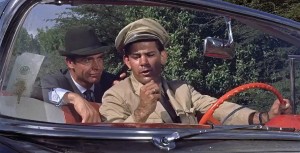
The Bond we recognize from later films, smirking in the face of danger, doesn’t appear in Dr. No. The first installment, instead, is marked by a profound tone of Cold War paranoia. Bond has always had to be on guard against a sudden double-cross, but suspicion reigns throughout the story here, denying Bond any opportunity to relax.
Bond marches through Palisadoes Airport in Kingston as if it were enemy territory. He doffs his hat to avoid being photographed by a woman with a camera, whom we discover (later) is an enemy agent. Is this Bond’s preternatural sense of the opposition, or just an instinctive antipathy toward being spotted? When a limo driver greets Bond by name, claiming to have come from Government House, Bond politely demurs until he can call his local contact. There he confirms what he first suspected – that the driver is, in fact, another enemy agent.
And behind all this is the mysterious white man in large sunglasses, shadowing Bond’s every move. This turns out to be CIA agent Felix Leiter – Jack Lord, six years away from his star turn on Hawaii Five-O – but we don’t know that at the time. So Bond is beset by three potential enemy agents or rival spies as soon as he sets foot in Jamaica. Though it’s thousands of miles away from the front lines of the Cold War, Bond can’t let his guard down.
This paranoia extends to Bond’s practices as well. While later films in the series would see Bond relying on gadgets to foil rival agencies, here his efforts are all improvised. He secures his hotel room with fingerprinting powder on his briefcase latches and a moistened hair affixed to a closet door. When laying in wait for the treasonous Professor Dent, he decorates a living room and bedroom with signs of seduction: two glasses of liquor, a sportcoat tossed in the corner of a couch, the bedsheets wound around a bolster pillow (posing as his sleeping form). To avoid guards on the sinister island of Crab Key, he cuts reeds to act as snorkel tubes – a far cry from the pocket-sized breathing apparatus he would use in Thunderball.
The focus on procedure – how to secure a room for tamper detection, how to set an ambush – serves two purposes. The first is to communicate an air of paranoia without relying on exposition. Instead of murmuring about being on his guard – or, worse, having a sidekick to narrate to – we get several wordless but artfully scored scenes of Bond setting traps. It’s a minor bit of craft, remarkable only in how deftly it’s used here and how much you notice its absence in poorer films.
The second purpose is to instill a sense of verisimilitude. Yes, Bond could have access to high-tech gadgets – and would, in the later films – but their role in the film is legerdemain. How do we know Bond’s briefcase will spray tear gas if opened wrong (as it does in From Russia with Love)? Because Q tells him it will. The technology behind such a device may as well be magic, for all that we know about it. But we recognize the purpose of a hair on a doorframe without being told. This makes sense to us as a means of tamper detection, and therefore it communicates Bond’s intentions more readily.
There are countless other examples – the cyanide cigarette an agent uses to suicide under interrogation; the poison Bond sniffs out in his hotel vodka – but these should suffice. Later Bond films would depict the protagonist as a confident, durable agent of the Crown, equally at home in any environment. While he’s no less competent here, we also get much more of a sense of how alone he is. Bond has to rely on his wits as much as his gadgets, his weapons, and his martial skills. He’s on the front line of a real war – as Connery himself would observe twenty-eight years later in The Hunt for Red October, a war with no monuments; only casualties.
THAT’S A DOM PERIGNON ’55; IT WOULD BE A PITY TO BREAK IT
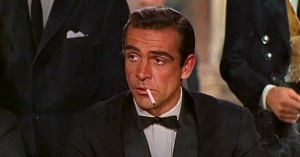
Ian Fleming wrote the Bond novels partly to turn some of his own experiences during wartime into escapist fiction, but partly as a way to indulge his own tastes and vices as well. Fleming admitted as much in a 1958 letter responding to critical disdain for the novel Dr. No, suggesting that Bond’s preference for high-end food and liquor was a rejection of processed, packaged fare.
We are first introduced to Bond at the baccarat table of a ritzy London casino, gambling being one of Fleming’s favorite pastimes. The variant he’s playing, chemin de fer, is not the same as North American baccarat, which is a game of pure chance. Chemin de fer plays like blackjack, but with a collection of players against one player (called the bank), with only one card available to hit, and the goal being to get your hand to total nine points through some odd arithmetic.
In the game that we watch in Dr. No, Bond is acting as bank, while his opponent, Ms. Sylvia Trench, is the only player with the credit (or the stones) to play against him. As bank, Bond has no opportunity to take a third card and improve his hand. What, then, is being tested in this game? That’s the purpose of all gambling scenes in films, especially in the Bond series: to either prove or tarnish a character’s mettle, or insight, or skill at bluffing, in concrete piles of chips.
All that Bond is testing, by his run of fortune as the bank, is his luck. Going on a prolonged winning streak as the bank in chemin de fer means you’re very lucky. That’s all. It’s like staying at the table for ten rounds of roulette. But perhaps that tells us something about Bond in itself. Consider the steely impatience with which Trench asks for her credit to be extended, so that she can keep playing. Consider the casual disregard with which Bond accepts her request to place a bet beyond the table limit. James Bond is a man who can stare implacable chance in the face and accept its offerings, good or bad, without sweating. It’s all the same to him, and it’s what we would expect of a modern samurai who’s fully comfortable with the notion of dying tomorrow. This is the sort of behavior that could come off as suicidally reckless – consider Mel Gibson’s Detective Riggs in Lethal Weapon – but Bond plays it off with impervious cool.
Just as Bond’s hair on the doorframe and dust on the briefcase are wordless touches to portray his caution, Bond’s high-stakes gambling and top-shelf liquor are props to depict his coolness. We first see Bond’s signature martini when a bellhop prepares it for him in his hotel room. We see the bellhop shake the martini maker, and comment on how it was “mixed like you said, sir, and not stirred.” Later, as a prisoner in Dr. No’s lair, he’s presented with an identical martini, already made and set just so on a literal silver platter. Why don’t we see Bond make the martini himself? Because that’s manual labor, beneath a jet-setter like him. He will occasionally pour a drink to relax in the evening, but all that business of measuring and mixing?
Tim Carvell, a writer for The Daily Show, observed recently on Twitter, “I feel like the whole James Bond franchise would unravel if there were just one scene of him trying to fold a fitted sheet.” We can not conceive of Bond doing anything common, like reheating last night’s Chinese in the microwave or being told his baggage has been misrouted. Every mundane detail must arrive promptly, with artful presentation, and without exerting a drop of sweat. When Bond has to struggle, it’s because the fate of the world is at stake, not because his dry cleaning isn’t ready yet. Bond’s energy has to be conserved for the important battles. The Jamaican hotel rooms, the exacting drink orders – these are the velvet case in which the Walther PPK is nestled.
It’s important to note that when Bond does struggle, he gets genuinely ragged. In escaping from a prison cell in Dr. No’s island fortress, he crawls down a steaming hot vent, shocks himself on an electric trap, gets buffeted by a torrent of water, and tumbles a great distance. He emerges from his ordeal bloody and disheveled, a visible contrast to his unruffled earlier appearance. Not for him the minimal level of sexy sweat that afflicts action heroes of the 90s and 00s: he gets dirty when he has to. But every mundane detail up to this point must be effortless.
THAT’S A SMITH AND WESSON, AND YOU’VE HAD YOUR SIX
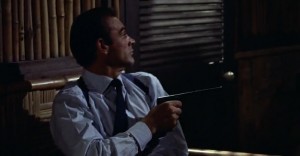
There’s something to be said for the image of James Bond as a weapon in a velvet-lined case. In Dr. No we see Bond at his earliest as a character and his most brutal, operating at a level of coldness we won’t see again until Timothy Dalton portrays him in the bloodthirsty Eighties. Like a machine, he is kept cool, well-oiled and idle until needed. Then he springs into action, striking with no remorse.
Examples abound: when he suspects a freelance photographer of spying on him, he gets his sidekick Quarrel to literally twist her arm until she talks. When Quarrel offers to actually break her arm – which may be a bluff, but could just as easily be a serious offer – Bond waves him off, not out of mercy for the girl but because he knows she won’t yield any more intel. Later, when flirting with a secretary whom he suspects of being an enemy agent, he playfully slips a towel off her neck. As he follows her into the bedroom, his face hardens, and he winds the towel around his hands like a garrotte. (Of course, he ends up sleeping with her rather than murdering her, but either seemed tolerable)
The most telling example, and one of the most memorable scenes of the movie, is when Bond confronts the man who orchestrated the murder Bond was sent to investigate. The murderer draws down on Bond, but he’s already emptied his magazine into a decoy. Bond coolly informs him of this fact, then shoots him twice. In the scene as filmed, Bond actually shoots the man six times – a mirror image of the six rounds the assassin fired? brutal overkill for murdering a British intelligence officer? – but the censors scaled this back.
This level of coldness hews closely to Fleming’s conception of the character. He described Bond in a 1962 New Yorker interview as a “blunt instrument.” Several characters in early Bond novels, particularly females, remarked on Bond’s “cold eyes” or the cruelty and ruthlessness of his face. Bond didn’t even have much of a sense of humor until Connery’s portrayal gave him one, leading Fleming to write later novels with wry touches.
Fleming, a former Naval intelligence officer, came into his own during World War II. He formed and directed commando teams such as 30 Assault Unit, whose exploits included the seizure of Axis battle plans prior to Operation Torch and the capture of Nazi scientists. Fleming also inspired Operation Mincemeat: creating a fake British soldier from a cadaver and giving him forged papers to convince the Germans that the Allies were landing in Greece, not Sicily. Fleming served the British Empire by coolly concocting schemes that required tremendous precision and lightning speed in execution. While brainstorming ways to outwit the Abwehr, he must have wished for faultless, emotionless men to execute them. Perhaps Bond was a manifestation of that wish.
MONEYPENNY! WHAT GIVES?
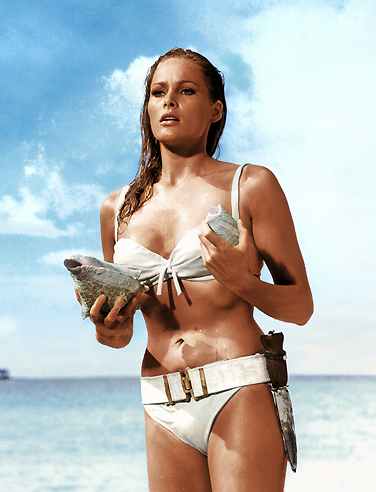
Bond’s required effortlessness also explains his success with women. Women don’t just fall for Bond in Dr. No: they throw themselves at him. Bond arranges a golf game and a dinner date with Sylvia Trench after meeting her and beating her in chemin de fer, all in about thirty seconds of conversation. That’s not enough for Trench, though, who breaks into his apartment and dons one of his shirts (after doffing everything else, of course) to await his return. Later, Bond asks one of the Government House secretaries out on a date, mere seconds after meeting her. “What should I say to an invitation from a strange gentleman?” she asks. “You should say yes,” Bond replies, and she soon does.
Is this unrealistic? Of course, even for a man as handsome as Sean Connery. But the image of Bond would fall apart if we saw him stammering his way through a pick-up line, or even if we saw him dumbstruck at female beauty. When Bond sees a girl, whether it’s Ursula Andress emerging from the ocean in Dr. No or Halle Berry doing the same in Die Another Day, his reaction is not stupor but the warm contemplation of how nice it would be to have her. And have her he inevitably does. There is anticipation, but never uncertainty.
This brings us to the sticking point of any James Bond retrospective: the sexism.
We see a statuesque blonde curling up in a man’s strong arms, and our first instinct is to think, “Ah, right, this movie is fifty years old.” But that by itself is not sufficient. Dr. No was released in the UK in 1962, the same year as Helen Gurley Brown’s Sex and the Single Girl. The film debuted in America in 1963, the same year as Betty Friedan’s The Feminine Mystique. Doris Day and Rock Hudson had already released two of their bedroom comedies, Pillow Talk and Lover Come Back, in which Day played capable, independent career women. While second-wave feminism had not yet kicked off, the groundwork was already in place. Women did not have to be depicted as helpless trophies unless that was how the artist saw them.
Nearly every woman Bond meets in Dr. No either sleeps with him or wants to. Sylvia Trench (as mentioned above) can’t even wait twelve hours for their promised golf date and ambushes Bond in his apartment. Miss Taro, Colonel Strangways’s treacherous secretary, sleeps with Bond in order to delay him until an assassin arrives. Even the desk clerk at Bond’s hotel stares after him with longing after handing him his key.
But while there are many girls in Bond’s life, every movie features a unique Bond Girl as well. Ursula Andress inaugurated the tradition as Honey Ryder, a shell diver whom Bond finds on Dr. No’s island completely by accident. She reacts to him with cold distrust at first, threatening him with a belt knife. We later learn that she was raised on a Jamaican plantation after her father died and that the plantation owner forced himself on her. She took her revenge, putting a black widow spider in his bed, and has apparently been leery of male contact ever since. Spoiler alert: this doesn’t last.
Ryder’s softening inaugurates one of the odder traditions of the series: the healing power of Bond’s dick. Sleeping with James Bond can make a damaged woman whole again, as it does to Ryder. It can make an enemy agent into a loyal ally (From Russia with Love), turn a lesbian straight (Goldfinger), make meek women strong (Live and Let Die), and even soothe the open wounds of revenge (For Your Eyes Only). It had become enough of a trope by Thunderball, only the fourth film in the series, that the villainous Fiona Volpe could comment on it with a sneer.
The redemptive power of sex with James Bond springs from two sources. First, Fleming apparently viewed Bond’s hypermasculinity as an actual tonic – “a subconscious protest against the current fashion for sexual confusion,” to quote the same letter referenced earlier. A strong, sexy man would literally heal a broken world, if only such a hero existed. Second, it’s an additional element of narrative tension. Bond beds every woman he comes across – ah, except this one. She’s been hurt in the past! She’s on a quest for revenge! She’s from the other side of the Iron Curtain! Herein lies the challenge, unfolding in parallel with the rising action of the mission, and often (ahem) climaxing shortly after the mission is accomplished.
JAMES BOND WILL RETURN
Some elements of Dr. No, like the universal paranoia or the unflinching brutality, did not last much longer through the series, being replaced with a wry enthusiasm. But some elements became institutional: the style, the wit, and of course the women. As the perils of World War II and the Cold War began to fade in memory, the hard heroes that such perils required fell out of demand. But the taste for the finer things in life is eternal, and on that strength the Bond franchise might coast for another fifty years.
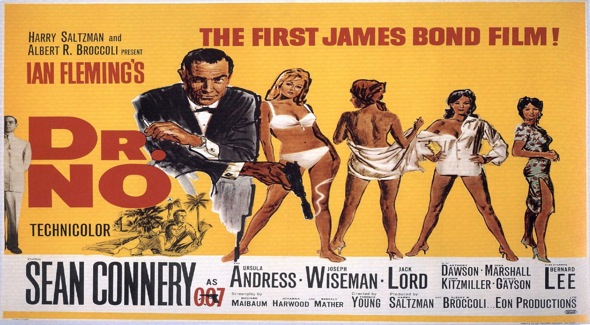
1954 teleplay of Casino Royale — Peter Lorre as Le Chiffre! I can almost overlook their decision to make Bond American, but calling him “Jim” is unforgivable.
Great article on Dr. No. I feel that the next movie to portray Bond as “real” was On Her Majesty’s Secret Service with George Lazenby. There’s a scene where he’s running from Telly Savalas and his gang at a ski resort, and rather than pull some crazy hijinks with technology, or martial arts, etc, he can only do one thing: hide. And so he sits down, pulls his collar up, and with a concerned look tries to wait it out. Thanks, John for a good read.
I remember reading “Live and Let Die” about fifteen years ago, and thinking about what a difference twenty years can make…The novel was set in the mid-50s, and the movie was set in the mid-70s, and there I was reading it in the mid-90s. I enjoyed both versions, Flemming’s original version and Roger Moore’s depiction, but have always thought that it would be cool to remake the Bond movies as “period pieces” and set them in the time the novels were writen. Putting Bond back in this context, I think, appeals to me not as a pureist, but as a history buff- Commander Bond, whom, ten years earlier, helped defeat the Nazis is now 007 defending the crown and her allies against the red menace. People who were not alive or not old enough to appreciate the fall of the Berlin Wall probably don’t really understand all of the Cold War cloak-and-dagger,or how real the threat of a nuclear war with the Soviet Union was to us, and so with the reboot of the franchise (Casino Royale in 2006), we get terrorists with somewhat murky motives in a modern, iPod world that makes the gadgets of the past seem ridiculous. I enjoyed Casino Royale, but after watching it, I thought, “well, that’s it. James Bond cannot exist in the 21st Century, at least not as he was. For proof, all you need is to go back to a few years befoe the reboot and read the articles that speculated on making 007 a woman, or black (not African-American- James Bond is English, after all, and I don’t imagine black people in the UK appreciate being called “African-American” when they are, in fact, neither). It may be time to pay our last respects to Commander Bond…or, pay him tribute by reproducing his exploits, as I said, “in Period.” Or, better yet, have Sean Connery return for one more appearance as James Bond, acnowledging the fact that time has, indeed, passed.